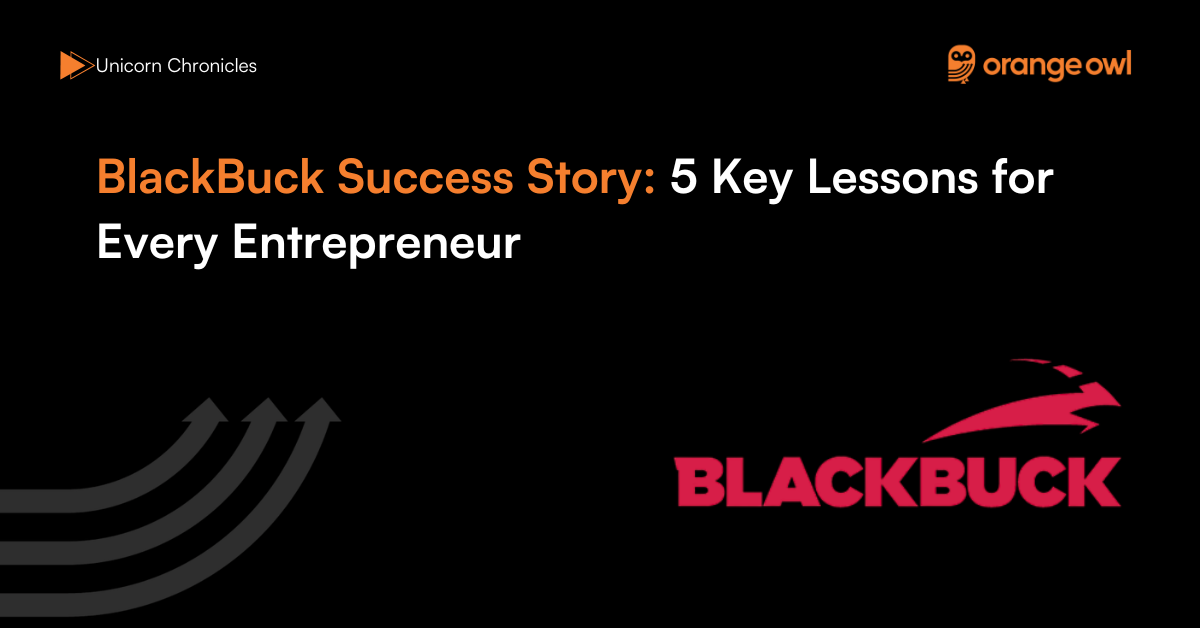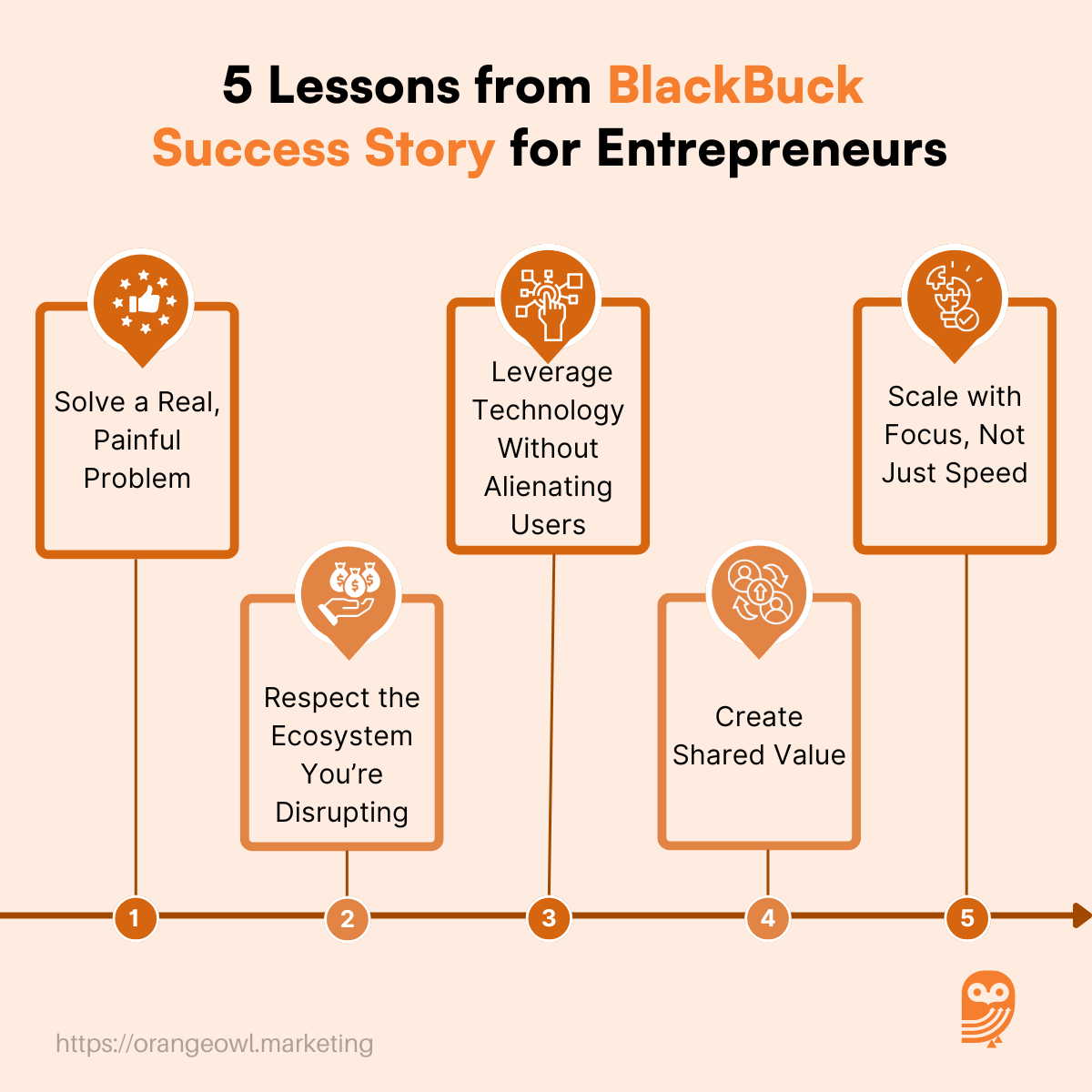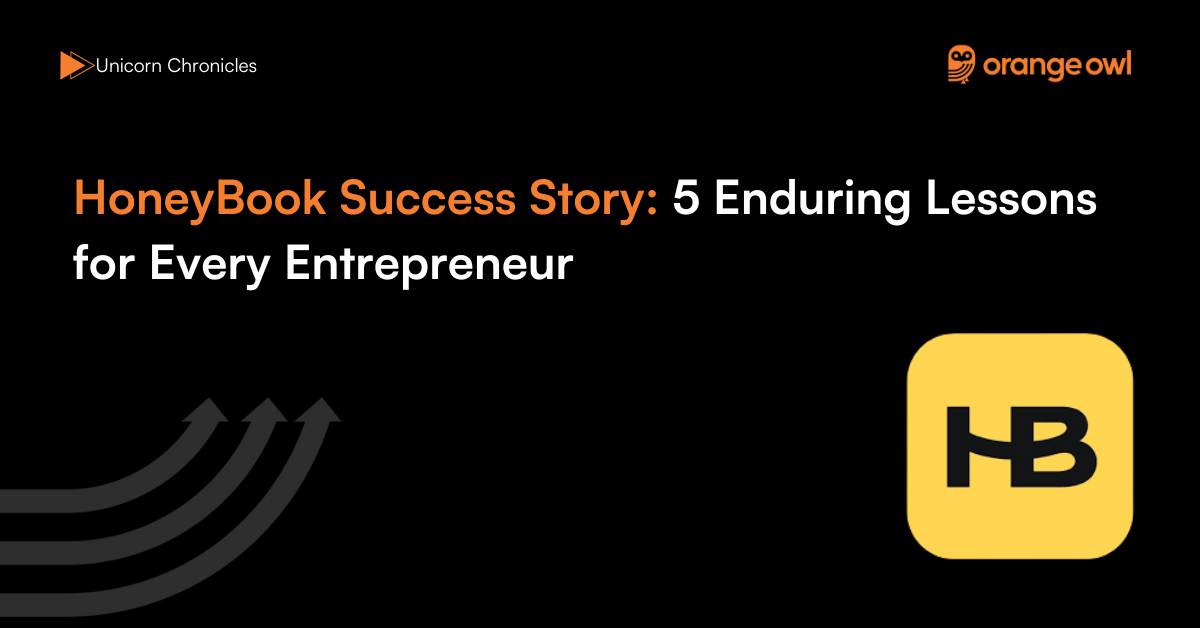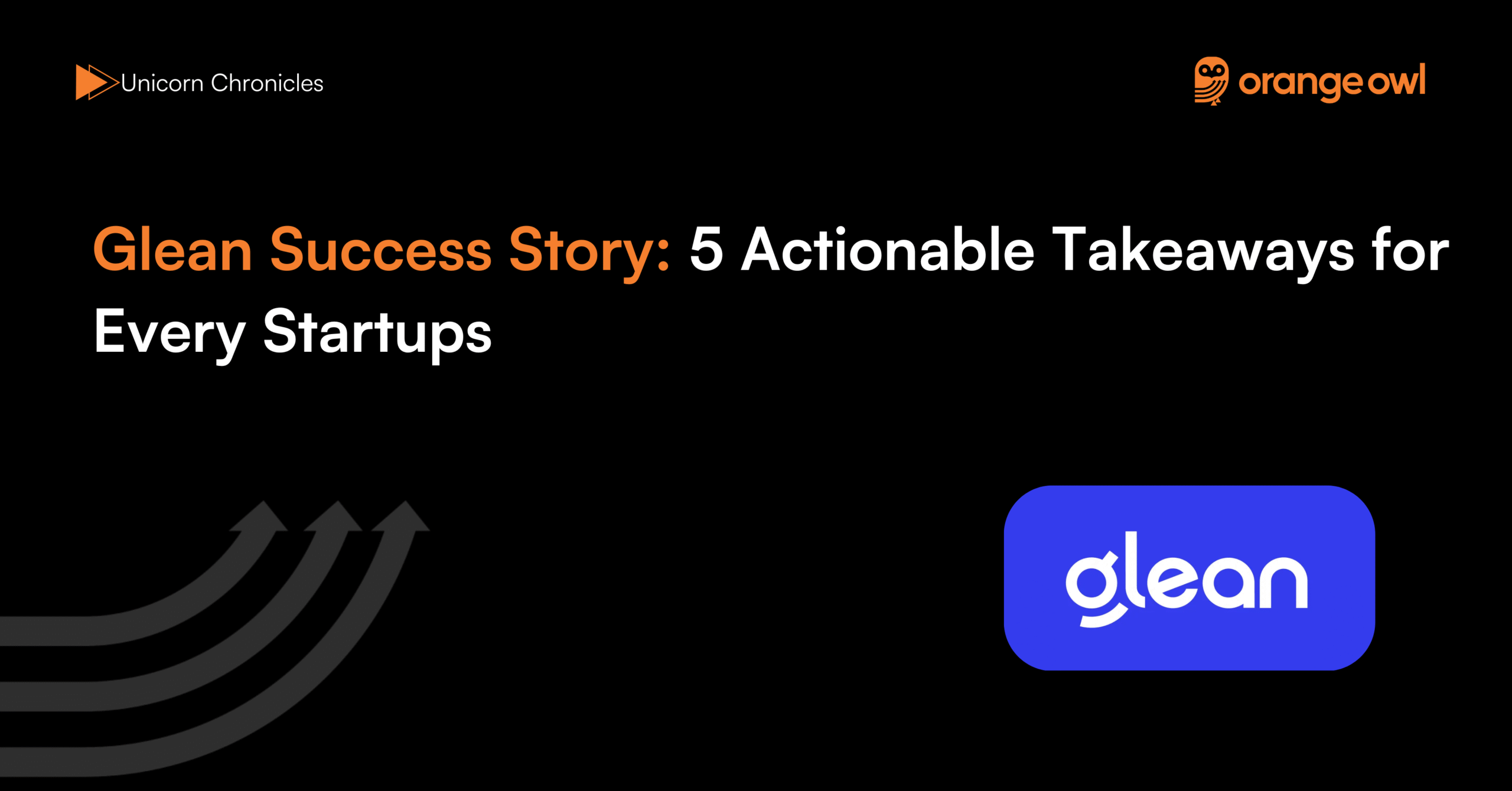BlackBuck Success Story: 5 Insightful Lessons for Every Entrepreneur
Vivek Goel
June 17, 2025

Table of Contents
Introduction
In India’s vast and complex logistics sector, BlackBuck has established itself as a leading digital trucking platform, revolutionising the way freight is transported across the country. Founded in 2015 in Bengaluru by Ramasubramanian B, Chanakya Hridaya, and Rajesh Yabaji, BlackBuck bridges the gap between fleet operators and truckers through its innovative technology-driven ecosystem.
BlackBuck offers a comprehensive suite of services, including load management, GPS tracking, fuel management, digital payments at toll booths and fueling stations, and telematics solutions that enhance transparency and efficiency in freight operations. The platform connects shippers with fleet operators in real time, enabling seamless cargo movement with features such as online payments, transaction history, order tracking, and dispute resolution.
With $359 million raised across 13 funding rounds from marquee investors like Accel, Sands Capital, and Flipkart, BlackBuck has grown rapidly to become the #1 player among 159 active competitors in India’s logistics tech market. The company reported an impressive annual revenue of ₹317 crore (approximately USD 38 million) as of March 2024 and employs over 1,500 people as of April 2025.
In 2021, BlackBuck achieved unicorn status after raising $67 million in Series E funding led by Tribe Capital, IFC, and VEF, which valued the company at $1.02 billion. Recently, BlackBuck went public, marking a significant milestone in its journey from a startup to a powerhouse in India’s transportation and logistics tech space.
Today, BlackBuck empowers over one-third of India’s truck operators, driving the digital transformation of a traditionally fragmented and offline industry. The company’s innovative platform—from freight matching and payments to telematics and loans—is redefining how India’s $200 billion+ trucking industry operates.
The BlackBuck story is a compelling example of how technology and innovation can unlock value in legacy sectors, creating new efficiencies and opportunities in one of India’s most critical infrastructure markets.
Origin Story
The origin of BlackBuck dates back to 2015, when three visionary founders, Ramasubramanian B, Chanakya Hridaya, and Rajesh Yabaji, recognised a persistent challenge in India’s trucking industry. Despite being the backbone of the country’s logistics, the trucking sector was largely fragmented, offline, and inefficient, with fleet operators and truckers struggling to find reliable ways to connect and manage freight.
Motivated by this gap, the founders set out from Bengaluru with a clear mission: to build a technology-driven platform that could digitally transform India’s vast trucking ecosystem. Drawing on their diverse backgrounds in logistics, technology, and operations, they aimed to create a seamless marketplace that would connect fleet owners with truck drivers, simplify freight management, and bring transparency to an industry long plagued by inefficiencies.
Initially, BlackBuck focused on building a basic load-matching system to help truckers find available shipments, but soon expanded its offerings to include GPS tracking, fuel management, digital payments, and telematics.
“Our goal was to empower truckers and fleet operators with tools that improve their livelihoods and productivity,” said Rajesh Yabaji.
Starting with modest resources and a small team, BlackBuck gradually won the trust of users by providing reliable services and consistent value in a traditionally offline industry. This focus on technology and user experience laid the foundation for BlackBuck’s rapid growth and its eventual emergence as a market leader, driving the digital transformation of India’s trucking sector.
Business Space and Early Challenges
Entering the Indian logistics and transportation sector came with its own set of challenges. The trucking industry, despite being a $ 200 B+ backbone of the Indian economy, was heavily unorganised, manual, and relationship-driven. Transactions typically took place over phone calls, personal networks, and middlemen, with little to no transparency, real-time tracking, or digital documentation.
When BlackBuck was founded in 2015, the idea of digitising freight operations was still nascent. Convincing truckers, fleet operators, and shippers—many of whom were accustomed to traditional ways of doing business—to adopt a tech-first approach was a significant hurdle.
As Rajesh Yabaji recalled, “The biggest challenge wasn’t the technology. It was getting people to trust it.”
Adding to this complexity was the diversity of the Indian trucking ecosystem, with multiple languages, routes, and operational styles. Building a scalable tech solution that worked across different geographies, vehicle types, and cargo segments required immense on-ground understanding and adaptation.
Another challenge was the initial lack of digital infrastructure among users. Most truckers did not use smartphones or digital payment methods, making it difficult to onboard them at scale. BlackBuck had to invest heavily in training, user onboarding, and trust-building measures to gain traction.
Despite these obstacles, the team remained focused on creating a seamless, end-to-end platform that addressed the pain points of all stakeholders. They rolled out features like GPS tracking, fuel card systems, and real-time load matching, which provided immediate value and slowly drove digital adoption across the network.
BlackBuck’s early success came not just from its technology, but from its deep empathy for the trucking community and its on-the-ground execution. By turning operational hurdles into strategic learnings, BlackBuck laid the groundwork for becoming India’s most trusted digital freight platform.
Growth Strategies
BlackBuck’s impressive growth trajectory has been powered by a blend of strategic vision, technological innovation, and a deep understanding of India’s logistics landscape. What began as a freight matching platform soon transformed into a comprehensive digital ecosystem, offering solutions for payments, toll and fuel management, GPS tracking, fleet financing, and telematics.
This diversification of services allowed BlackBuck to address the end-to-end needs of both shippers and fleet operators. As Rajesh Yabaji noted,
“We realised early that to build long-term trust, we had to solve multiple pain points—not just one.”
A crucial part of its growth strategy was platform stickiness. Features like real-time tracking, Fastag integration, digital documentation, and fuel cards not only improved operational efficiency but also made it easier for users to rely on BlackBuck for daily business. This led to higher engagement and stronger network effects.
To expand rapidly, BlackBuck focused on bringing truckers online at scale. The company invested in hyperlocal outreach, multilingual onboarding, and field support teams to ensure adoption even in remote regions. This supply-side activation paid off—by 2025, over one-third of India’s truckers were active monthly users.
Additionally, BlackBuck pursued data-driven optimisation to enhance its offerings. Using AI and machine learning, the company fine-tuned route planning, pricing, and demand forecasting, improving earnings for truckers while delivering better outcomes for shippers.
As it matured, BlackBuck also formed strategic partnerships with e-commerce, FMCG, and manufacturing giants to ensure consistent freight volume. This B2B integration helped scale operations while reinforcing trust across India’s fragmented logistics sector.
The company’s recent IPO was a landmark moment, marking its evolution from a fast-scaling startup to a market leader in logistics tech—a position it earned by turning everyday freight into a seamless, digital-first experience.
Marketing Strategies
BlackBuck’s rise as India’s leading digital freight platform was not just driven by technology—it was powered by sharp, focused marketing strategies that helped the brand build trust in a sector known for opacity and fragmentation. At the core of BlackBuck’s outreach was community-centric storytelling. Rather than selling software, BlackBuck focused on humanising the trucker’s journey, creating narratives around empowerment, opportunity, and transformation through technology.
A key pillar of its strategy was educational marketing. The company invested in regional, vernacular content that explained the benefits of digitisation—how GPS tracking could improve earnings, how Fastag integration could reduce wait times, or how digital payments could eliminate cash leakage. This helped convert sceptical operators into loyal users.
To build credibility within the trucking ecosystem, BlackBuck launched on-ground activations such as fleet partner meets, driver onboarding camps, and highway outreach programs. These initiatives not only offered product demonstrations but also gave the brand a grassroots presence in India’s trucking hubs—from Ludhiana to Coimbatore. The face-to-face connection was crucial in a space where trust is earned more through relationships than through advertisements.
BlackBuck also ran targeted digital campaigns across WhatsApp, YouTube, and regional language apps to reach truckers and fleet owners where they spent time online. These campaigns focused on ROI-led messaging like cost savings, faster payments, and better fleet utilisation—demonstrating tangible value.
Additionally, BlackBuck built an in-app loyalty ecosystem, rewarding frequent users with discounts on fuel, tolls, and insurance, turning everyday transactions into engagement levers. This not only drove retention but also positioned BlackBuck as a partner in their professional journey.
Finally, BlackBuck’s brand messaging consistently celebrated the dignity and importance of the trucker—a narrative largely missing from mainstream logistics branding. By honouring the “real heroes of Indian logistics,” BlackBuck not only carved a niche for itself but also created an emotional connect with its core user base.
5 Insightful Lessons for Every Entrepreneur
1. Solve a Real, Painful Problem
BlackBuck’s journey began with a deep understanding of a broken and inefficient logistics industry. Instead of jumping onto a trend, the founders focused on solving a tangible pain point: the underutilisation of trucks and the lack of tech-driven freight matching in India. Their sharp problem-solution fit—connecting truckers with shippers via a digital platform—enabled massive impact from day one.
The takeaway? Don’t chase buzzwords. Solve a real problem that deeply affects a large group of people, and your startup will always be relevant.
2. Respect the Ecosystem You’re Disrupting
While BlackBuck was building a digital-first platform, it never ignored the human, relationship-driven nature of Indian logistics. Trucking in India runs on trust, negotiation, and personal networks, and BlackBuck respected that. It earned trust through ground-level engagement, regional language support, and personalised onboarding.
Lesson for entrepreneurs: When disrupting traditional industries, remember—empathy matters as much as efficiency.
3. Leverage Technology Without Alienating Users
BlackBuck succeeded not by throwing high-end tech at a legacy industry, but by introducing simple, intuitive digital tools that truckers and shippers could adopt gradually. Features like real-time tracking, digital payments, and e-toll integration were introduced thoughtfully, with training and support.
This proves that adoption isn’t about how advanced your tech is—it’s about how accessible it feels.
4. Create Shared Value
From fuel discounts to Fastag benefits and load guarantees, BlackBuck’s business model focused on creating economic benefits for both sides of the marketplace—shippers saved time and money, and truckers earned more consistently.
Founders should ask: “Does my platform make everyone better off?” Creating shared value ensures retention, loyalty, and word-of-mouth growth.
5. Scale with Focus, Not Just Speed
BlackBuck expanded rapidly but chose depth over breadth. It focused first on key trucking corridors, built density, and then scaled intelligently across India. Even in the face of high demand, it resisted the urge to scale recklessly.
This highlights a critical truth for founders: Hypergrowth means nothing without operational discipline. Scale when your core engine is working, not just because the market looks tempting.
Conclusion
BlackBuck’s transformation from a small Bengaluru-based startup to one of India’s leading logistics-tech unicorns is a testament to how deep industry insight, digital innovation, and grassroots execution can redefine even the most traditional sectors. What began as an effort to bring structure to India’s highly unorganised trucking ecosystem has evolved into a full-fledged digital freight network, enabling smarter, faster, and more reliable cargo movement across the country.
In a market fraught with supply chain inefficiencies, middlemen dependency, and outdated systems, BlackBuck showed that change is possible, not by replacing people, but by empowering them with technology. By building trust with both truckers and enterprises, simplifying onboarding, and scaling thoughtfully, the company didn’t just digitise logistics—it humanised it.
As co-founder Rajesh Yabaji aptly said, “We didn’t aim to replace the trucking industry. We wanted to build the rails that would help it move faster.” This approach has not only led to operational scale but also to a lasting impact on how logistics is perceived and managed in India.
For entrepreneurs, the BlackBuck success story offers a powerful lesson: true disruption doesn’t come from technology alone—it comes from understanding the pulse of the people you serve, solving their pain points, and scaling with empathy and intent. In doing so, you won’t just digitise an industry—you’ll move a nation forward.



